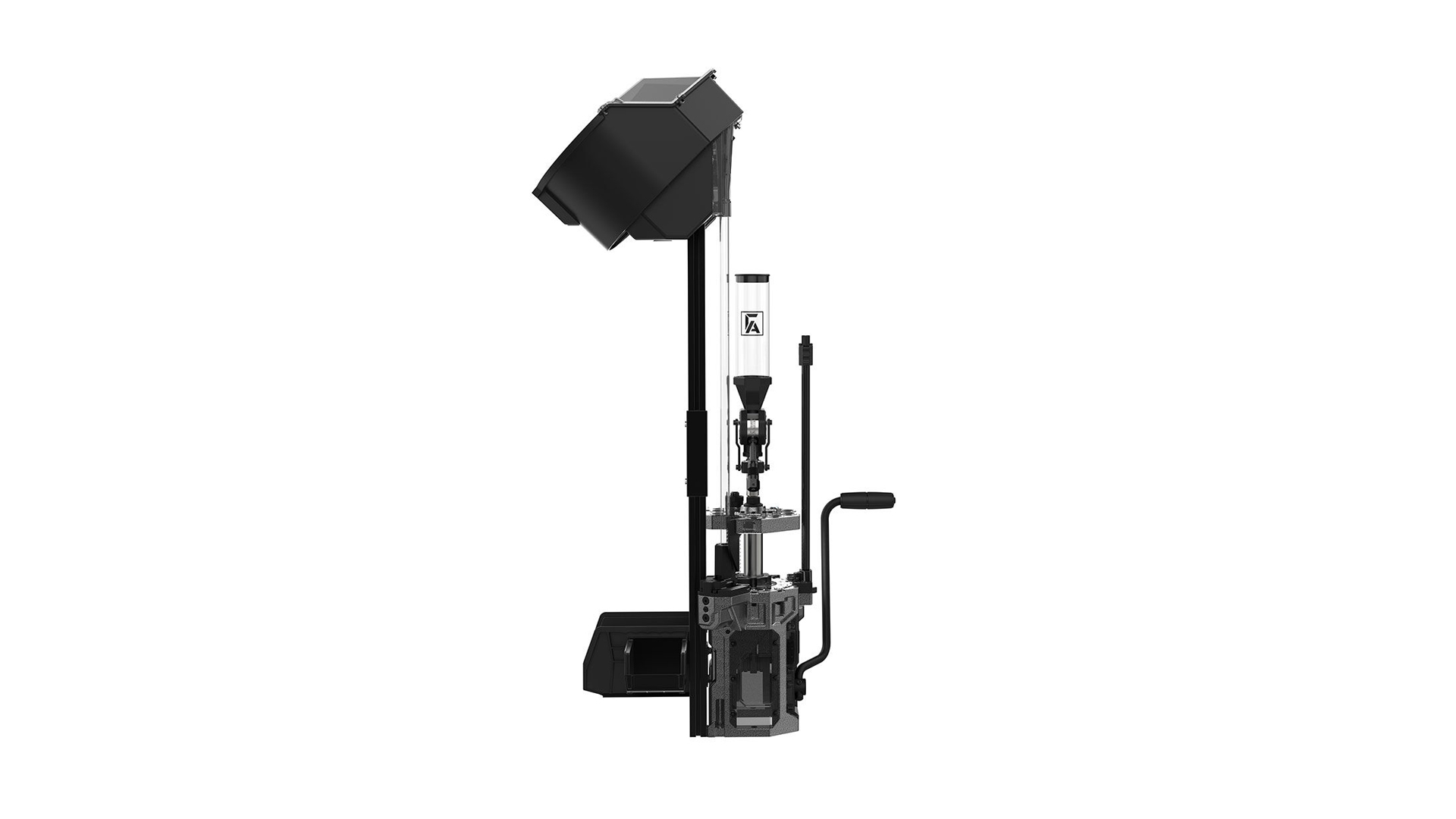
Progressive loaders are the mainstay of any high-volume shooter, and just like the rounds they make, more is better when talking about the number of stations. While presses with as few as three stages can get the job done, packing all of the operations into such few strokes invites trouble and can become harrowing to set up. The gold standard is the magic number “10,” as this offers enough space to separate each step and even add a few others that go a long way toward ensuring a smooth loading experience. In the past, presses of this pedigree fetched more than $2,200, which is a tough pill to swallow, even if it will eventually pay for itself. Therefore, when Frankford Arsenal announced its X-10 progressive press for nearly half that cost ($1,200), I needed to mount one up and get a closer look.

As indicated by its name, the X-10 carries that same 10-stage configuration that separates the best presses from the ones that are merely adequate. In addition, it includes an automatic case feeder, illuminated loading deck, low-primer sensor and brackets to hold bins for completed rounds and bullets to expedite the loading process. For my testing, I wanted to take one from the box through loading its first 100 rounds, so naturally, we must start with assembly.
As luck would have it, the press arrived with its core mechanism already assembled, leaving not much else to do. As I unpacked and began the setup of X-10 components, the first aspect that caught my eye was how well-balanced it was. Pulling the handle exerts a force within the press that is linear and straight down, meaning it doesn’t ask much from whatever you plan to bolt it to. This design affords the assembler a variety of possible fixtures, whether temporary or permanent. Even a simple board affixed to a cart or workbench should suffice, which is precisely the route I took, as I could stow it away between loading sessions.

With the press firmly clamped to a utility cart, I unwrapped the shell plates and was introduced to the level of quality to which this press was built. Typically, these parts are simplistic and, for lack of a better phrase, rough-cut. The X-10 plate is highly polished and works on a system of ball bearings, yielding a smoother press stroke. While this may seem like a sheer luxury, if your shell plate stutters during rotation, you are likely going to spill powder. This stammering cycle is not only dangerous, it will create less-consistent ammunition. Worst of all, the spilled powder finds its way into other mechanisms and leads to malfunctioning parts.

After selecting and inserting the correct plate for 9 mm Luger cartridges, I unwrapped the tool head and prepared it for assembly. This unit houses up to eight standard, 7/8x14 TPI dies and is interchangeable with others that are available at frankfordarsenal.com. Why interchangeable, you ask? Well, this replaceable unit allows users swap between preconfigured die and load arrangements without losing a setting. To remove everything and swap to another unit is as simple as loosening one bolt, and all the settings stay with the tool head. This hastens conversions dramatically and also seems to lower my blood pressure. I joke, but setting powder throws to a tolerance of 0.1 grain and seating depths to 0.001 takes a lot of patience and attention; there is nothing like never having to go through that process more than once.

We share our home range with the Air National Guard and, as such, crimped military brass frequently litters the firing line. When one of these buggers gets mixed in with my commercial brass, it has the potential to bring the loading process to a grinding halt. So, the last part of the X-10 setup process was to adjust the swaging die and pin to roll out any military crimp that might have been left behind in my used brass. Next to that pin is the primer punch that is also adjustable, something that I have always deemed necessary, as primers can be set deeper or shallower than others. Once those adjustments were made, it was time to get loading. I selected a set of Hornady custom-grade dies and a standalone Lyman taper-crimp die, set them up as I would in any other press, and moved toward component selection for making my 9 mm rounds.

It is important to note that progressive presses work best with flake or ball powders, as they flow through the measures smoothly and consistently. For this reason, I picked Hodgdon Titegroup, as I’ve always enjoyed success through its use in 9 mm ammunition, and it yields a fair bit more loaded rounds per pound. This allows room in the budget for better primers, so CCI 500s found their way onto my bench as well. Interestingly enough, not all primers are identical on the outside. Some are a tad larger, and some are a tad undersized. While this goes largely unnoticed in manual priming rigs, it can be a nightmare when the process is progressive. CCIs have been the most consistent in my experience and, for a few extra dollars, offer better-performing ammunition and less headache to get there.

As I already had a spackle bucket full of mixed 9 mm brass, all that was left was to choose the projectile. Progressive handloading is naturally high-volume, so bulk bullets rise above the rest for this process. X-treme Bullets offers its 124-grain projectiles in 500-count boxes, which are exceptional for bulk loading tasks. Their plated composition keeps them clean and reduces the chance of ricochet when shooting steel targets, which makes them an easy sell, and I have found them to perform just as well as conventional copper-jacketed bullets while costing a good deal less.

All that was left was to adjust the measurements for a 4.2-grain powder throw before I could get to cranking away at the X-10. To make sure the press was functioning properly, I started with a single cartridge case. This allows you to check each stage individually. The first two operations were sizing and swaging properly. After leaving what is considered the fourth station, the case rotated into the priming stage, where it was primed on the downstroke. I have mixed feelings about that. The order of operations ties in other operations at this point, and a jam can go unnoticed until it possibly ignites the primer. However, a downstroke priming system does make for a simpler routine and eliminates the chance of forgetting to seat a primer, so there is that advantage. I did like that the primer feeding system offers an inspection window so that you can ensure primers are in queue any time you care to peek into it. I was also a big fan of the low primer alarm and how it is activated once you reach only 12 primers left. This gives you ample notice to refill, which is important because single primers by themselves in the rotation tend to flip as they fall into position. From here, the case was flared and then charged in two separate operations. While compact, the “powder-through-expander” system is known to spill a few flakes when a charged case is pulled from the measurer. This causes you to slow down to keep things neat and consistent. Separating the two is another significant step toward making safe and accurate ammunition. Seating and crimping were the last steps, and these, too, were conducted in separate operations. I liked this because many built-in crimp systems are reliant on case length. If this length varies enough, they will either receive too much crimp or not enough. I have found that standalone taper dies are a bit more forgiving in this respect and are also easier to set up and adjust.

After my first round was ejected from stage 10, I decided to power up the case feeder and begin mass production. At this point of the process, I was able to work with the adjustment door and motor speed to find the setting that worked best for the 9 mm cartridge I was loading. Another nicety of the X-10 press is that, once the case tube was filled, the motor shut off, making for a quieter loading experience. With it running, I was able to crank off my first 100 rounds at a rate of 540 per hour. This was at a slow, cautious pace consistent with that of a new operator on a new machine. With a bit of time behind the handle, I can easily see hitting 700 rounds an hour or even 1,000 if I install a bullet feeder. More importantly, all completed ammunition fit my Lyman 100-round ammo checker, telling me that what I just cranked out is going to feed reliably in any 9 mm Luger firearm that I own.
As I cleaned out the powder measure, I found the one area that could use improvement, and that would be a quick-detach system to remove it from the tool head. Although it only requires the removal of three screws to separate it from the press, it could be annoying if you only plan on loading a few rounds in a session. Of course, that can be compensated by limiting your loading sessions to large runs that can be quantified by the thousand. That might sound like a big job, but with this machine, that could happen in something as short as a lunch break. An inexpensive progressive that is fast to set up and makes quality ammunition. Aside from a pre-pandemic flow of primers, what else could we ask for?
For more information, visit frankfordarsenal.com.




































